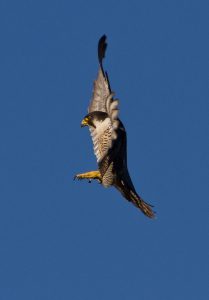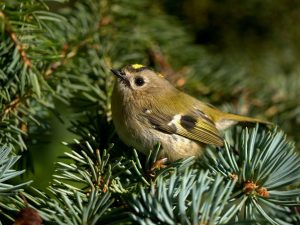
The peregrine falcon is undoubtedly one of Ireland’s most impressive birds. A large, powerful falcon it is considered by many to be the ultimate bird-of-prey, diving in a spectacular, vertical stoop to strike its quarry – other birds – in mid air. The peregrine is thought to reach speeds of up to 180 mph as it plummets earthward, though it usually levels off slightly and slows before striking its prey with outstretched talons. The razor-sharp claw of the hind-toe delivers the killing blow with the leg partially flexed on impact. Stricken prey is often allowed to drop to the ground before the raptor circles back to collect its prize.
In the summer months peregrines can be seen around the coastal cliffs, mountain crags and inland quarries on which they breed. In winter they frequent favourite hunting grounds like moorland, marshes and estuaries, where pandemonium amongst other birds often heralds the approach of these supreme aerial hunters.
The peregrine is around 45cm (17½ inches) long with a robust build. Adults are a dark, blue-grey above and white below. The breast is barred with black – with the much larger female showing more prominent barring than the male. Peregrines have a distinctive moustache of dark plumage either side of the face that stands out against the pale breast and cheeks. Juveniles have browner plumage than the adults, a less prominent moustache and have vertical streaks rather than horizontal bars below. Flight is generally a series of rapid wing-beats followed by a prolonged glide. The bird also spends long periods perched, shoulders hunched, ever watchful.
Peregrine populations were severely affected by the widespread use of organochlorine pesticides like DDT during the 1950’s and 60’s. At the time these pesticides were commonly added to seeds. While these seeds contained a relatively low quantity of pesticide the chemicals became concentrated in the tissues of pigeons and other birds, which ate the treated seeds in large numbers. Peregrines would then eat numerous contaminated birds, resulting in a further concentration of the pesticide in the falcons. While not always lethal to the adult birds, these high concentrations of pesticide would render them sterile or caused them to lay very brittle eggs that shattered under the weight of the female as she tried to incubate them. Peregrine numbers plummeted to dangerously low levels.
Since the 1970’s a ban on these pesticides has allowed peregrine populations to slowly recover across much of their northern European range, including here in Ireland, where we now have an estimated 265 breeding pairs in the Republic and a further 100 pairs in the North. Peregrines rear a single brood of chicks each year. Between April and June the female lays three to four buff-coloured eggs with red speckles on the nest site or eyrie, typically a rocky ledge on a steep cliff-face. Incubation takes around twenty-eight days and the young birds fledge between thirty-five and forty-two days after hatching.
During the winter months peregrine numbers increase considerably as birds from further north in their range visit Ireland, following their migratory prey species south. For many people the winter months offer the best chance of spotting a peregrine as the birds patrol the skies over estuaries, mud flats and coastal waterways around the country.









15 comments
Tomas Gaffney
Are there counts and tracking of falcons in ireland .
martin sparks
are peregrine falcons not kestrels? are they the only bird of prey in Ireland that can truly hover?
Calvin Jones
No. Peregrines are much bigger, more powerful birds than kestrels, although they belong to the same falcon family. Kestrels are the only Irish bird of prey that can truly hover, although buzzards can make a fair attempt at it in the right circumstances.
Jo
I just went to the back garden and a large bird just got spooked flying fast away being trees. It left a pigeon on the grass beside the oil tank. Since I was curious about the bird I kept on eye on the place for about 5 min and a Peregrine Falcon came to finish his dinner. After 10 min took the half eaten Pigeon and left.
Colm
I live just out side Virginia cavan. We seem to have one in the Marsh out the back field. It makes quite a lot of noise. My understanding they only do that when near there nest. Would that be right.
Nathalia
I have one coming to my garden .
Trish Cummins
Hi I am just curious to know, how are these birds counted how are the figures got as to how many we have in the Republic.
Calvin Jones
Hi Trish,
The National Parks and Wildlife Service coordinates periodic nationwide surveys of peregrine breeding sites which allows them to estimate the number of active breeding pairs. There are also regional monitoring programmes. Based on results of those surveys ecologists can calculate reasonably accurate estimates of population levels and trends.
Denis McClean (@Denis_McClean)
I’ve been privileged to see Peregrines hunting in Clare and Mayo, usually off sea cliffs and boy do they move. Their high speed aerobatics have to be seen to be believed. Young birds can look a bit like Kestrels except for those huge eyes and meaty appearance. They can look quite thuggish when they are not airborne/
Suzanne Sheehan
Hi Calvin , I live in co cork, I think we may have a juvenile peregrine hunting around our field, he is brown in colour, white breast and back of legs. We have an abundance of rabbits this year, we normally wouldn’t. I’ve watched this bird sit and watch for over an hour waiting for food. Does this sound like a peregrine to you?
Calvin Jones
No Suzanne… it sounds much more like a buzzard. Peregrines are exclusively bird predators — they hunt other birds on the wing. If it’s hanging around looking for rabbits and scavenging then it’s not a peregrine. Still cool to have buzzards around — they were a scarce bird in Cork not long ago, but the population seems to have reached some sort of tipping point and they’re becoming quite numerous now. Fantastic birds.
Mary Walsh
Are there any peregraine falcons in captivity in Ireland? Also in July or August 2018 where in Ireland are they mostly lightly to be seen. I have a young serious inthusist in the here
Calvin Jones
Peregrines are found all over Ireland — through the summer they are breeding on upland crags, coastal cliffs, and even now on tall buildings in our cities. July and August will see the young fledging — they’ll hang around the breeding territory for a while, being fed by the parents and learning to hunt for themselves, and then will disperse as we come to late summer early autumn.
In winter look out for peregrines patrolling coastal mudflats and estuaries where they feed on the large numbers of waders that overwinter here.
In terms of captive peregrines, you’ll likely find them at most falconry centres around the country — either injured/rehabilitated birds that couldn’t make it back into the wild, or captive bred birds specifically for falconry. There’s really no substitute for seeing this supreme aerial predator in its natural environment though. Quite simply breathtaking!
Noel o herlihy
Are there nightingales in ireland?
Calvin Jones
No Noel… they don’t breed here… they only turn up occasionally as very rare passage migrants in spring or autumn.